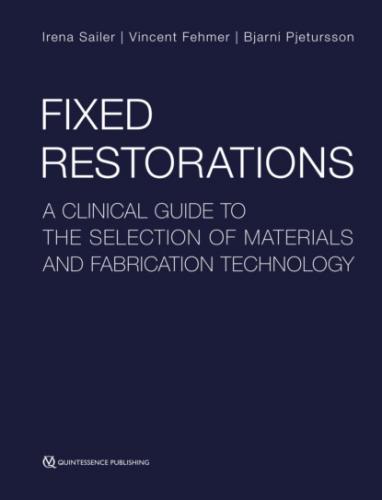Fixed Restorations. Irena Sailer
Patient demands
■ Esthetic requirements – prerequisites
■ Amount and quality of tooth substance
■ Amount and quality of soft tissues
■ Occlusal and functional requirements
The selection of the restorative material is a crucial step within the rehabilitation of patients with fixed restorations, as the material is of high importance for the esthetics and the long-term performance of the fixed tooth- and implant-supported restorations. The restorative team, ie, the dentist and dental technician, need to be aware of the indications, advantages and limitations of all restorative materials in order to select the most appropriate alternative for the specific patient situation (Part I, Chapter 1).
Today, the selection of the material also includes the selection of the fabrication technology and, consequently, the efficiency (time, costs) and efficacy (predictability of outcomes) of the treatment.
In this chapter, the clinically relevant patient-based factors for the material selection will be discussed.
The thorough evaluation and definition of the patient expectations at the beginning of the treatment is possibly the most important Part of a prosthetic rehabilitation.The patient demands for dental improvement can focus on the following factors:
■ esthetics
■ occlusion and function
■ intraoral health.
A patient may have only one priority or may desire to improve several or all of these factors with the proposed treatment. Esthetics is probably the most complex patient demand for a prosthetic rehabilitation when considering the material selection. Some esthetic prosthetic materials exhibit low stability (see Part I, Chapter 1), feldspathic ceramics being a good example. Besides good esthetics, the restoration has to withstand the conditions of the oral environment for long-term periods. With this in mind, the selection of material for esthetic rehabilitation needs to include such parameters as the position in the jaws (anterior, posterior), occlusal and functional scheme, expected occlusal forces, and quality of substrate for adhesive cementation (abutment tooth, implant abutment).
Dental esthetics has generally become a very important Part of well-being today1,2. Patients research social media and the internet on methods of self-improvement.3 It has been shown that the improvement of dental esthetics contributes to self-improvement independent of culture or gender1,2. Frequently, patients approach the dental office with a clear treatment goal in mind after having researched the internet. They won’t hesitate changing dentist to receive the desired treatment, if their current dentist is not willing to perform it due to medical/dental or other reasons. This can complicate the professional relationship with the patients today. A thesis, focusing on factors that influence the demands of patients for restorative treatment, demonstrated the importance of the relationship of confidence and competence between clinicians and dental technicians and patients4.
Communication of the treatment goal and the individual treatment steps is crucial for the establishment of confidence between the restorative team and the patients. The discussion and the decision-making process between patients and the restorative team is simplified if the foreseen treatment goal has been visualized in the diagnostic phase, either by a conventional, manually made wax-up and set-up, or by virtual wax-ups and set-ups using CAD5.
Hence, prior to any prosthetic treatment the patient-oriented treatment goal needs to be defined through comprehensive pre-treatment diagnostics (see also Part I, Chapter 4). Diagnostics is the key element to the execution of the treatment, the selection of the restorative material, and shared decision-making.
From an esthetic point of view, the material selection depends on the color of the substrate, ie, the abutment tooth or the implant abutment, and the optical properties of the remaining dentition (technical factor, see Part I, Chapter 3).
In situations with no or only slight discoloration, all restorative materials can be used. The selection of the respective material depends more on factors like the available space and the region of the jaw (see decision trees, Part I, Chapter 12).
In situations with discoloration, however, the selection of the restorative material becomes more complex (Fig 1-2-1). Dental ceramics are translucent materials, and depending on the type of microstructure their translucency varies. Glass-ceramics are rather translucent and have low masking ability. In order to improve their masking ability, the thickness of the ceramic needs to be increased. Oxide ceramics have more opaque properties and, therefore, better masking quality (Fig 1-2-2).
Fig 1-2-1a to 1-2-1e Overview of different abutment teeth in the esthetic area displaying the potential differences in color of the substrate, that have to be considered at the restorative material selection.
Fig 1-2-2 Translucency of different ceramic materials. From left to right; the leucite-reinforced glass-ceramic, feldspathic ceramic, zirconia, In-Ceram alumina, and In-Ceram zirconia samples have the same thickness (0.5 mm), and show obvious differences in translucency.
To mask the same discoloration different amounts of space may be required depending on the ceramic. It has been shown that a thickness of at least 1.2–1.5 mm of glass-ceramic is needed to cover dark discolorations6. To mask discolorations with this type of ceramic induces a need for more invasive preparations. The same applies also to oxide ceramics like zirconia; however, this ceramic is also influenced by the color of the substrate and the cement used for the fixation of the restorations at thicknesses below 1 mm7,8. In situations with intense dark discoloration, metal-ceramics may be the most appropriate material combination for the masking.
1.2.4 Amount and quality of tooth substance
The amount and the quality of the abutment tooth substance influence the selection of the restoration type (eg, overlay or crown), and of the respective restorative material. The conventional prosthetic treatment concepts are in transition today, shifting from full fixed/removable partial prostheses to less invasive,
